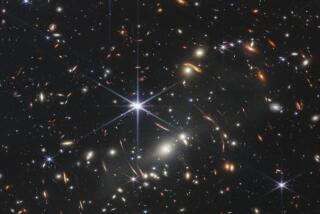Moon Holds Clues to Earth’s Distant Past
- Share via
Twenty years ago this week, on July 20, 1969, human beings set foot for the first time on a world other than Earth itself. Neil Armstrong stepped down onto the moon’s surface and said, “This is one small step for a man, one giant leap for mankind.”
There were five more visits to the moon in the next few years, and then they stopped. No one has visited the moon now in 17 years. So as we celebrate the 20th anniversary of that first moon landing, we might ask: What was it all for? Did we get anything out of it? Was there really a giant leap?
Well, yes; the moon landings gave us a valuable chance to learn about its--and our--far past.
The Earth and the moon, and the whole solar system, in fact, came into being about 4.5 billion years ago. We can learn about the Earth’s distant past by studying its rock formations. Naturally, the older the rock and the longer it has existed in Earth’s crust unchanged, the further back our knowledge can be pushed.
However, the key word there is unchanged. Rocks don’t remain unchanged forever. The Earth’s crust shifts and rocks are crushed and melted and reformed. The force of moving air and water introduces changes even when the rocks aren’t actually melted. And life itself changes the landscape enormously.
The result is that the oldest rocks we can find are a little more than 3 billion years old and there aren’t many of those. We have difficulty extending our knowledge of Earth’s history back that far, and as for the first 1.5 billion years of Earth’s existence, forget it. It remains a complete blank, and as long as we are imprisoned on Earth itself, it will continue to remain a complete blank.
The moon, however, is a smaller body. Its gravitational pull is insufficient to hold an atmosphere or any liquid that evaporates easily. That means there is no air on the moon, and no water, and no life. Not only is there none now, but there never was any. That, in turn, means that the surface has not been interfered with by the action of life or by wind or by waves. What’s more, being a smaller body, the moon has developed less internal heat, and it is internal heat that keeps the crust moving and changing even if nothing else does. In other words, whereas the Earth is geologically “alive,” the moon is virtually geologically “dead.”
This means the surface of the moon can continue to exist unchanged for much longer than the surface of the Earth can, and the moon rocks that the astronauts brought back are a billion years older than the oldest rocks we can find on Earth’s surface. We can fill in a billion years of early history that the Earth is silent about.
The moon was created (it is currently thought) when, very early in Earth’s history, the planet was clobbered by an object about the size of Mars. That knocked a huge quantity of Earth’s surface layers into nearby space while the striking body fused with Earth.
The material that was knocked into space was heated to a vapor but it cooled into a mass of innumerable particles of various sizes and these gradually coalesced and formed the moon. Since the moon was formed from the outer layers of Earth, it is almost entirely rocky and includes very little dense iron like that found at the Earth’s core. That is why the moon is less dense than Earth.
It took a few hundred million years for the moon to cool down sufficiently to have a solid crust, but about 4 billion years ago that solid crust was there, and the oldest rocks that have been brought back date from that period.
In the last 4 billion years, the only significant changes undergone by the moon happened when it gathered in the remaining objects that still existed in its vicinity. These formed the numerous craters and the vast “seas” that now cover its surface. From the rocks we have brought back, we can study the different stages of that bombardment. The early history was the most active, of course, since there were still many objects with which to collide.
As time went on, space was cleared of most of the objects and the moon settled down and underwent fewer and fewer other changes. From about 3.2 billion years ago onward, things were relatively quiet--for Earth as well as the moon, for if the moon was bombarded, so was the Earth. It’s just that on Earth the craters produced by that bombardment have worn away, thanks to winds, waves and life, whereas on the moon they remain.
Yet there have been changes on the moon comparatively recently, too. The crater of Copernicus was formed 810 million years ago, and the spectacular crater of Tycho was formed only 109 million years ago. Some small craters were formed as recently as 2 million years ago.
If we were to go back to the moon, then, quite apart from its uses as an observatory, a mining station and a new home for human beings, a careful and painstaking study of its surface could fill in all the details of its history and from that we could deduce what took place on the early Earth, too.






